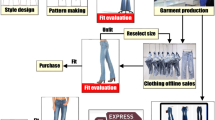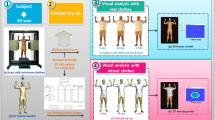Abstract
Fit evaluation plays an important role in garment products development and sales. Effective clothing fit evaluation methods can reduce the development cost of apparel products and the return rate of online apparel sales. In this research, we proposed an intelligent fit evaluation technology to predict clothing fit. The mathematical relationship model between clothing fit levels and indexes reflecting the clothing fit levels was constructed by using decision tree C4.5 algorithm. Then, two experiments were carried out to collect input and output training data. After learning from the collected data, the proposed model can predict clothing fit accurately. Next, we validated our proposed model’s prediction accuracy using K-fold cross validation. Finally, we gave two applications of the proposed model for clothing products development and shopping online. Results show that our proposed method has high prediction accuracy and less requirement for the number of learning samples, and can predict clothing fit automatically and rapidly without real try-on.








Similar content being viewed by others
Data availability
The datasets generated during the current study are available from the corresponding author on reasonable request.
References
Ashdown SP, Dunne L (2006) A study of automated custom fit: readiness of the technology for the apparel industry. Cloth Text Res J 24:121–136
Chattaraman V, Simmons KP, Ulrich PV (2013) Age, body size, body image, and fit preferences of male consumers. Cloth Text Res J 31:291–305
Chen C-M (2007) Fit evaluation within the made-to-measure process. Int J Cloth Sci Technol 19:131–144
Chen X, Tao X, Zeng X, Koehl L, Boulenguez-Phippen J (2015) Control and optimization of human perception on virtual garment products by learning from experimental data. Knowl-Based Syst 87:92–101
Chiew KL, Tan CL, Wong K, Yong KS, Tiong WK (2019) A new hybrid ensemble feature selection framework for machine learning-based phishing detection system. Inf Sci 484:153–166
Dutt A, Ismail MA, Herawan T (2017) A systematic review on educational data mining. IEEE Access 5:15991–16005
Guo Z, Wong W, Leung S, Li M (2011) Applications of artificial intelligence in the apparel industry: a review. Text Res J 81:1871–1892
Han L, Li W, Su Z (2019) An assertive reasoning method for emergency response management based on knowledge elements C4.5 decision tree. Expert Syst Appl 122:65–74
Huck J, Maganga O, Kim Y (1997) Protective overalls: evaluation of garment design and fit. Int. J. Cloth. Sci. Technol. 9:45–61
Jiang Q, Jin X, Lee S-J, Yao S (2019) A new similarity/distance measure between intuitionistic fuzzy sets based on the transformed isosceles triangles and its applications to pattern recognition. Expert Syst Appl 116:439–453
Kausar S, Huahu X, Hussain I, Wenhao Z, Zahid M (2018) Integration of data mining clustering approach in the personalized E-learning system. IEEE Access 6:72724–72734
Kim H, Damhorst ML (2010) The relationship of body-related self-discrepancy to body dissatisfaction, apparel involvement, concerns with fit and size of garments, and purchase intentions in online apparel shopping. Cloth Text Res J 28:239–254
Lin Y-L, Wang M-JJ (2015) The development of a clothing fit evaluation system under virtual environment. Multimed Tools Appl 75:7575–7587
Liu K, Kamalha E, Wang J, Agrawal T-K (2016) Optimization Design of Cycling Clothes' patterns based on digital clothing pressures. Fiber Polym 17:1522–1529
Liu K, Wang J, Zhu C, Hong Y (2016) Development of upper cycling clothes using 3D-to-2D flattening technology and evaluation of dynamic wear comfort from the aspect of clothing pressure. Int J Cloth Sci Technol. 28:736–749
Liu K, Wang J, Zeng X, Tao X, Bruniaux P, Edwin K (2016) Fuzzy classification of young women's lower body based on anthropometric measurement. Int J Ind Ergonom 55:60–68
Liu K, Wang J, Hong Y (2017) Wearing comfort analysis from aspect of numerical garment pressure using 3D virtual-reality and data mining technology. Int J Cloth Sci Technol 29:166–179
Liu K, Zeng X, Bruniaux P, Wang J, Kamalha E, Tao X (2017) Fit evaluation of virtual garment try-on by learning from digital pressure data. Knowl-Based Syst 133:174–182
Liu K, Wang J, Kamalha E, Li V, Zeng X (2017) Construction of a body dimensions' prediction model for garment pattern making based on anthropometric data learning. J Text Inst 108:2107–2114
Liu K, Wang J, Zhu C, Kamalha E, Hong Y, Zhang J, Dong M (2017) A mixed human body modeling method based on 3d body scanning for clothing industry. Int J Cloth Sci Technol 29:673–685
Liu K, Zeng X, Bruniaux P, Tao X, Yao X, Li V, Wang J (2018) 3D interactive garment pattern-making technology. Comput Aided Des 104:113–124
Liu K, Zeng X, Wang J, Tao X, Xu J, Jiang X, Ren J, Kamalha E, Agrawal T-K, Bruniaux P (2018) Parametric design of garment flat based on body dimension. Int J Ind Ergonom 65:46–59
Liu K, Wu H, Zhu C, Wang J, Zeng X, Tao X, Bruniaux P (2022) An evaluation of garment fit to improve customer body fit of fashion design clothing. Int J Adv Manuf Tech 120:2685–2699
Lu Y, Song G, Li J (2014) A novel approach for fit analysis of thermal protective clothing using three-dimensional body scanning. Appl Ergon 45:1439–1446
Melin P, Sanchez D (2018) Multi-objective optimization for modular granular neural networks applied to pattern recognition. Inf Sci 460:594–610
Satam D, Liu Y, Lee HJ (2011) Intelligent design systems for apparel mass customization. J Text Inst 102:353–365
Shin E, Baytar F (2014) Apparel fit and size concerns and intentions to use virtual try-on: impacts of body satisfaction and images of models’ bodies. Cloth Text Res J 32:20–33
Sun P, Li J, Bhuiyan MZA, Wang L, Li B (2019) Modeling and clustering attacker activities in IoT through machine learning techniques. Inf Sci 479:456–471
Tao X, Bruniaux P (2013) Toward advanced three-dimensional modeling of garment prototype from draping technique. Int J Cloth Sci Technol 25:266–283
Tao X, Chen X, Zeng X, Koehl L (2018) A customized garment collaborative design process by using virtual reality and sensory evaluation on garment fit. Comput Ind Eng 115:683–695
Thomassey S, Bruniaux P (2013) A template of ease allowance for garments based on a 3D reverse methodology. Int J Ind Ergonom 43:406–416
Zhang X, Yeung K, Li Y (2002) Numerical simulation of 3D dynamic garment pressure. Text Res J 72:245–252
Zhao X, Fan K, Shi X, Liu K (2021) Virtual fit evaluation of pants using the adaptive network fuzzy inference system. Text Res J 91:2786–2794
Funding
This paper was financially supported by the National Natural Science Foundation of China (No. 61806161), the Natural Science Basic Research Program of Shaanxi Province, China (No. 2019JQ-848), the Innovation Ability Support Plan of Shaanxi Province-young Science and Technology Star Project, China (No. 2020KJXX-083), China and the Youth Innovation Team of Shaanxi Universities, China.
Author information
Authors and Affiliations
Corresponding author
Ethics declarations
Conflict of interest
The authors declare no conflict of interest.
Additional information
Publisher’s note
Springer Nature remains neutral with regard to jurisdictional claims in published maps and institutional affiliations.
Rights and permissions
Springer Nature or its licensor (e.g. a society or other partner) holds exclusive rights to this article under a publishing agreement with the author(s) or other rightsholder(s); author self-archiving of the accepted manuscript version of this article is solely governed by the terms of such publishing agreement and applicable law.
About this article
Cite this article
Liu, K., Zhu, C., Tao, X. et al. A novel evaluation technique for human body perception of clothing fit. Multimed Tools Appl 82, 21057–21069 (2023). https://doi.org/10.1007/s11042-023-14530-x
Received:
Revised:
Accepted:
Published:
Issue Date:
DOI: https://doi.org/10.1007/s11042-023-14530-x




